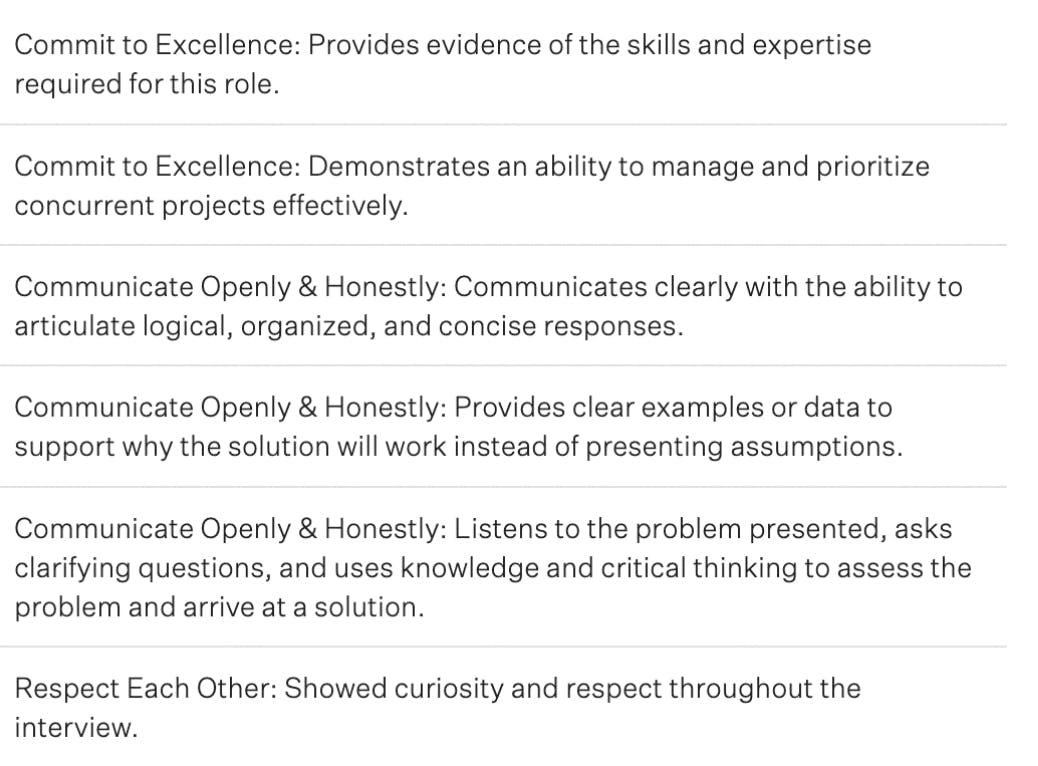When you’re hiring for startups, each search for a new teammate can feel like a make-or-break moment for the company’s success. With such great stakes, it’s all the more important to make facts-based, data-driven hiring decisions when interviewing new people. That’s why we’re huge fans of hiring rubrics at Cockroach Labs. Not only do they get us closer to hiring the right person for open roles, they also ensure we have a hiring process that reduces bias.
Of course, this is easier said than done. The challenges to developing rubrics mirror their benefits: they require consensus on what it takes to bolster your team’s skills, culture, and diversity.
What’s a Rubric?
According to the University of Texas at Austin, a rubric is “a tool that lets you objectively compare an applicant’s qualifications to a job vacancy’s qualifications and functions, as well as compare applicants… based on established job-related criteria.” This definition gets at the heart of why rubrics matter: when our hiring decisions match up to specific skills we’re looking for in each candidate for a role, we reduce the potential for bias.
Developing an Effective Rubric
When we adopted rubrics at the company-wide level, we built a set of standard, company-wide measures mapped to our company’s mission and values. We also built a template to kick off new searches which hiring managers and recruiters complete together. This allows them to align on the core skills required of that next hire while setting the standard for how we will evaluate candidates. Here’s what our company-wide rubric looks like on interview scorecards:
All of our teams are also enabled to build rubrics at the department-level which allow for more relevant criteria; for example, our engineering team developed rubrics that break interview performance down into five categories: technical excellence, communication, critical thinking, culture add, and potential. The engineering rubrics combine our company’s values with technical needs to create consistency across feedback for their team. Keep reading to learn more about culture add and potential.
When developing rubrics, it’s important to note: not each interview needs to reveal every skill; that’s why we gather more than one data point across a number of interviews. As we put it in our rubric-writing guide: “These categories are not meant to be rigid, but mutually constructive. Each section gives us an opportunity to advocate for candidates where we identify core strengths.”
The Rubric <-> Interview Feedback Loop
Some hiring teams build interviews first and rubrics later. We do things the other way around. We build exercise-based, resume-blind interviews to provide people with live opportunities to demonstrate their skills to our interviewers.
We believe that if you want to hire fairly, you must decide on exactly what you’re hoping to evaluate before you design the evaluations. Then, you can adjust the rubric to make sure it’s specific to the content of the interview!
Culture Add, Not Culture Fit
We don’t think culture fit is the right bar for prospective Roachers. A Harvard Business Review article sums it up nicely: “What most people really mean when they say someone is a good fit culturally is that he or she is someone they’d like to have a beer with… [but] very often the people we enjoy hanging out with have backgrounds much like our own.” This hinders diversity and doesn’t pass muster as a test of whether, one, someone can do the job, and two, they will benefit a company’s culture.
We prefer to consider culture add. We define “culture add” as any quality which would bring new or culturally beneficial experiences to our team. These aren’t requirements, but nice-to-haves that appear during a hiring process that can elevate someone’s candidacy. Perhaps a candidate has extensive experience mentoring junior employees, has a unique skill set outside of work that could prove valuable to their technical ability, or perhaps balances an existing team with a unique approach to communication (e.g., someone who’s more accustomed to asynchronous communication than live meetings).
Identifying a culture add quality allows us to diversify our team by highlighting ways a candidate might be an asset to growing our team’s abilities or perspectives.
Inclusive Rubric Essentials
Here are some other ways to make your rubrics iron-clad:
Build a Scoring Standard: Beyond setting criteria for evaluating hiring decisions, it’s also a good idea to set a scoring standard across these criteria and map different interview performance indicators to discrete scores. We use Strong No, No, Yes, and Strong Yes in our rubrics, which equate to a score from 1 to 4, respectively.
Work with Hiring Teams: Getting hiring managers and interviewers involved in building rubrics allows us to run consensus-driven hiring. We agree on how we evaluate candidates at the start and we agree on how we choose candidates during hiring committees.
Leave Room for Potential: The goal of creating rubrics isn’t to make hiring robotic— quite the opposite. Rubrics make hiring more human by leveling the playing field. To take it a step further, we consider a candidate’s potential in many of our interviews. If we interview a candidate who has strengths in many, but not all, of our criteria, but they still demonstrate an ability to learn quickly and commit to excellence, they might still be hired!
Building Better Teams with Rubrics
Standardization alone doesn’t combat bias or grow diversity. If we lean too hard on traditional evaluation methods, we risk shutting out prospective Roachers who have the ability, but not the access, to excel. Combining core criteria with additional room for advocacy in areas such as culture add and potential, we can evaluate candidates on key strengths while also championing growth for new employees, and our own team, in the process.
If you’re curious to see our interview process in action or want to be a part of Cockroach Labs’ meteoric growth, check out our open roles.




